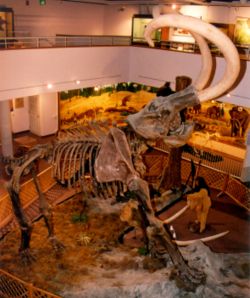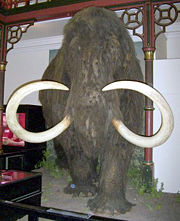Mammoth
2008/9 Schools Wikipedia Selection. Related subjects: Dinosaurs
| Mammoth Fossil range: Early Pliocene to Holocene |
||||||||||||
|---|---|---|---|---|---|---|---|---|---|---|---|---|
 Mount of a Columbian Mammoth
|
||||||||||||
| Scientific classification | ||||||||||||
|
||||||||||||
| Species | ||||||||||||
|
A mammoth is any species of the extinct genus Mammuthus. These proboscideans are members of the elephant family and close relatives of modern elephants. They were often equipped with long curved tusks and, in northern species, a covering of long hair. They lived from the Pliocene epoch from 4.8 million years ago to around 4,500 years ago. The word mammoth comes from the Russian мамонт mamont, probably in turn from the Vogul (Mansi) language.
Extinction
The woolly mammoth was the last species of the genus. Most populations of the woolly mammoth in North America and Eurasia died out at the end of the last Ice Age. Until recently, it was generally assumed that the last woolly mammoths vanished from Europe and Southern Siberia about 10,000 BC, but new findings show that some were still present here about 8,000 BC. Only slightly later, the woolly mammoths also disappeared from continental Northern Siberia. Woolly mammoths as well as Columbian mammoths disappeared from the North American continent at the end of the ice age. A small population survived on St. Paul Island, Alaska, up until 6000 BC, and the small mammoths of Wrangel Island became extinct only around 2000 BC.
A definitive explanation for their mass extinction is yet to be agreed upon. About 12,000 years ago, warmer, wetter weather was beginning to take hold. Rising sea levels swamped the coastal regions. Forests replaced open woodlands and grasslands across the continent. The Ice Age was ebbing. As their habitats disappeared, so did the bison and the mammoth.
Whether the general mammoth population died out for climatic reasons or due to overhunting by humans is controversial. Another theory suggests that mammoths may have fallen victim to an infectious disease. A combination of climate change and hunting by humans is the most likely explanation for their extinction.
New data derived from studies done on living elephants (see Levy 2006) suggests that though human hunting may not have been the primary cause for the mammoth's final extinction, human hunting was likely a strong contributing factor. Homo erectus is known to have consumed mammoth meat as early as 1.8 million years ago (Levy 2006: 295).
However, the American Institute of Biological Sciences also notes that bones of dead elephants, left on the ground and subsequently trampled by other elephants, tend to bear marks resembling butchery marks, which have previously been misinterpreted as such by archaeologists.
The survival of the dwarf mammoths on Russia's Wrangel Island was due to the fact that the island was very remote and uninhabited in the early Holocene period. The actual island was not discovered by modern civilization until the 1820s by American whalers. A similar dwarfing occurred with the Pygmy Mammoth on the outer Channel Islands of California, but at an earlier period. Those animals were very likely killed by early Paleo-Native Americans, and habitat loss caused by a rising sea level that split the Santa Rosae into the outer Channel Islands.
Thomas Jefferson, well-versed in the natural sciences, nevertheless suggested to Lewis and Clark that they might find mammoth fossils during their explorations of the American West.
Size

It is a common misconception that mammoths were much larger than modern elephants, an error that has led to "mammoth" being used as an adjective meaning "very big". Certainly, the largest known species, the Imperial Mammoth of California, reached heights of at least 5 metres (16 feet) at the shoulder. Mammoths would probably normally weigh in the region of 6 to 8 tonnes, but exceptionally large males may have exceeded 12 tonnes. A 3.3 m. (11 ft.) long mammoth tusk was discovered north of Lincoln, Illinois in 2005. However, most species of mammoth were only about as large as a modern Asian Elephant. Fossils of species of dwarf mammoth have been found on the Californian Channel Islands ( Mammuthus exilis) and the Mediterranean island of Sardinia (Mammuthus lamarmorae). There was also a race of dwarf woolly mammoths on Wrangel Island, north of Siberia, within the Arctic Circle.
Based on studies of their close relatives the modern elephants, mammoths probably had a gestation period of 22 months, resulting in a single calf being born. Their social structure was probably the same as that of African and Asian elephants, with females living in herds headed by a matriarch, whilst bulls lived solitary lives or formed loose groups after sexual maturity.
Well-preserved specimens
In May of 2007, the carcass of a six-month-old female woolly mammoth calf was discovered encased in a layer of permafrost near the Yuribei River in Russia where it had been buried for 37,000 years. Alexei Tikhonov, the Russian Academy of Science's Zoological Institute's deputy director, has dismissed the prospect of cloning the animal, as the whole cells required for cloning would have burst under the freezing conditions. DNA is expected to be well-preserved enough to be useful for research on mammoth phylogeny and perhaps physiology however.